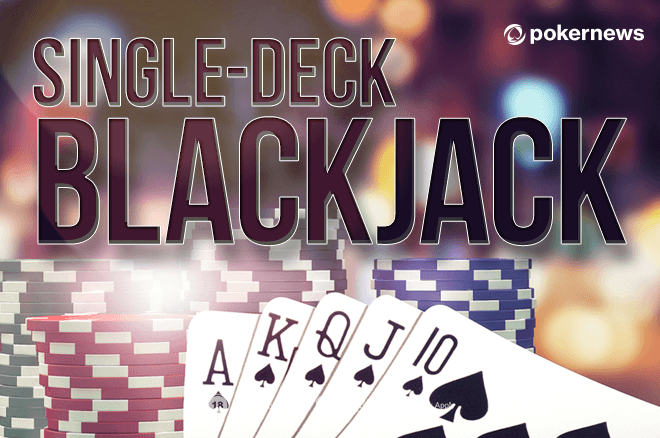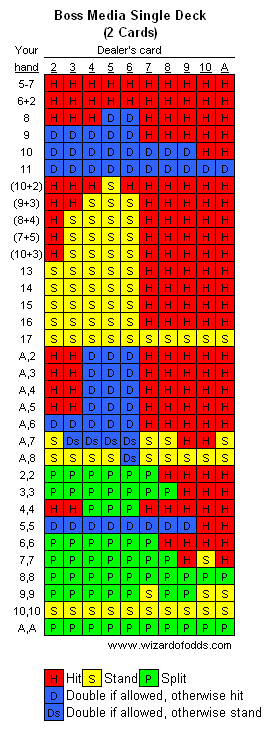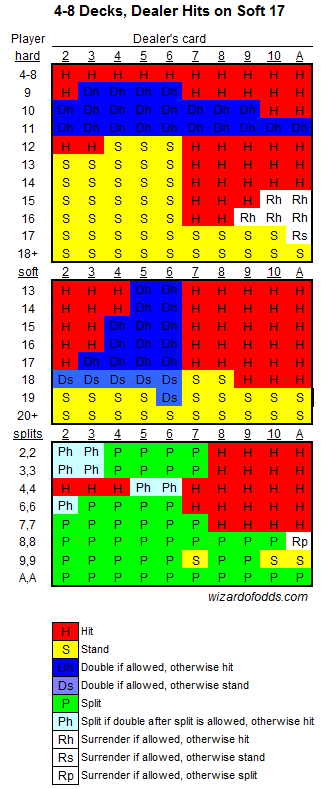Blackjack Single Deck Odds

- Blackjack Single Deck Odds Calculator
- Blackjack Single Deck Odds Poker
- Blackjack Single Deck Odds Nfl Week 11
- Blackjack Single Deck Odds Chart
- Blackjack Single Deck Odds Footings
- Single Deck Blackjack Odds
A single-deck game with H17 and RSA or just H17 has the lowest house edge of any blackjack game (0.13% and 0.19% respectively). There are some good double-deck blackjack games with a very low house edge against a basic strategy player (as low as 0.14%). Most of the time the free Blackjack Odds Single Deck Vs Multi Deck spins are offered on a specific slot machine, usually a new or promoted slot machine. Popular slot machines for free Blackjack Odds Single Deck Vs Multi Deck spins are Starburst, Gonzo’s Quest, Warlords, Mega Fortune Dreams, Scruffy Duck and Dazzle me.


Single Deck blackjack preys on the half-informed blackjack player if it only pays out at 6 to 5 for a blackjack. Almost everyone who steps into a casino knows that fewer decks mean better odds for blackjack players. At a time, card counters began to affect the odds of blackjack by counting cards. Vegas Single Deck Blackjack is often regarded as the top rung of the game since the odds on the player winning is simply the highest. The house edge is, in fact, merely 0.15% a single deck is used. Nevertheless, as with all things, really, even when playing Vegas Single Deck Blackjack there are both pros and cons. The Benefits of a Single Deck. Odds of drawing a blackjack in a one-deck shoe = 4.83%. Odds of drawing a blackjack in a two-deck shoe = 4.78%. By adding a deck (and not changing any rules of the game), the casino has decreased your likelihood of drawing a blackjack by 0.05%.
Perhaps the purest form of the game known as Blackjack, the version played with a single 52-card deck can still be found at many casinos and online. It was most common until the 1960s, when card-counting systems became widely known and casinos feared losing their house advantage. The use of multiple decks in play discourages counting and assures that the odds favor the dealer, with the house edge increasing slightly for each deck added.
Blackjack Single Deck Odds Calculator
In Single Deck Blackjack, the 52 cards are divided into four 13-card suits—clubs, diamonds, hearts, and spades. Kings, Queens, and Jacks have a value of 10 points, Aces can be counted as either 1 or 11, and all other cards are worth their face value, 2~10. The game is played directly against a dealer, and the object is to reach a card total higher than the dealer’s without exceeding 21.
The top hand in Single Deck Blackjack is an Ace and any 10-point card for a value of 21. This combination is called a natural or blackjack, and it beats any other hand. When it is a winner, a natural blackjack pays 3 to 2. Should both the player and the dealer have a blackjack, the result is a “push” and the player’s bet is returned.

All other winning hands pay 1 to 1 or “even money.” When either the player or dealer go over 21, the hand is called a “bust” and it automatically loses. Should both the player and the dealer bust, the dealer wins, and this where the house gets its built-in advantage. Whenever the player and the dealer tie, the bet is a push, as above.
Blackjack Single Deck Odds Poker

Hands containing at least one Ace that can still be valued at 21 points or less if the Ace is counted as 11 are said to be “soft.” These include such two-card combinations as the Ace-9 (soft 20), Ace-8 (soft 19), Ace-7 (soft 18), etc., and multi-card combinations, such as Ace-5-4 (soft 20), Ace-4-3 (soft 18), Ace-3-2-2 (soft 18), etc.
Blackjack Single Deck Odds Nfl Week 11
A game of Single Deck Blackjack begins with the dealer shuffling the cards and offering one player the opportunity to “cut” the deck. The top card on the resulting deck is “burned” (taken out of play) without showing it. During this time, players make their initial bets, placing chips in the betting circles in front of them.
Then, cards are dealt to each player clockwise from the dealer’s left until all players, including the dealer, have two cards. The dealer will turn one of his/her cards face up (the “up card”) for all to see. The dealer’s hidden card is called the “hole” card.
Blackjack Single Deck Odds Chart
Unless the up card is an Ace (see below), players will be given the opportunity to improve their hands by drawing one or more additional cards or by splitting “pairs” (two cards of the same value) to form two hands and increase their wagers accordingly. Other player options are to “stand” and receive no more cards, to “surrender” and give up half the wager by forfeiting the hand, or to “double” the wager and receive exactly one additional card and no more.
Blackjack Single Deck Odds Footings
A variety of rules dictate how Single Deck Blackjack is played by the dealer. For example, the dealer must stand on total of 17 or higher and draw to any count less than 17. Some Single Deck Blackjack tables have the dealer stand on soft 17, while others require a draw. From the player’s perspective, a dealer who stands on soft 17 is preferable, decreasing the house edge by about 0.2%.
When the dealer has an Ace showing, “insurance” can be purchased to guard against the dealer having a natural blackjack. To insure a hand, the player must make an additional wager up to 50% of the initial bet. If the dealer has a blackjack, the insurance bet will pay 2 to 1, the hand ends without further action, and the initial wager is saved. If the dealer does not hold a blackjack, the insurance bet is lost and the game continues.
Single Deck Blackjack Odds
One variation on insurance is the opportunity for a player holding a natural blackjack to claim “even money” when the dealer shows an Ace. In this case, the blackjack is immediately paid at 1 to 1 odds. If even money is not claimed, the player’s hand will pay nothing facing the dealer’s natural or 3 to 2 otherwise.